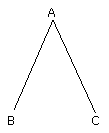To bisect a given rectilineal angle.
 Let the angle BAC be the given rectilineal angle.
Thus it is required to bisect it.
Let the angle BAC be the given rectilineal angle.
Thus it is required to bisect it.
 Let a point D be taken at random on AB
Let a point D be taken at random on AB
 let AE be cut off from AC equal to AD;
let AE be cut off from AC equal to AD;
 Let DE be joined,
Let DE be joined,
 and on DE let the equilateral triangle DEF be constructed;
and on DE let the equilateral triangle DEF be constructed;
 let AF be joined.
let AF be joined.
 I say that the angle BAC has been bisected by the straight line AF.
For, since AD is equal to AE,
and AF is common,
the two sides DA, AF are equal to the two sides EA, AF respectively.
And the base DF is equal to the base EF
I say that the angle BAC has been bisected by the straight line AF.
For, since AD is equal to AE,
and AF is common,
the two sides DA, AF are equal to the two sides EA, AF respectively.
And the base DF is equal to the base EF
 therefore the angle DAF is equal to the angle EAF.
therefore the angle DAF is equal to the angle EAF.
Therefore the given rectilineal angle BAC has been bisected by the
straight line AF.
Q.E.D
 As this is a construction, and within it two other constructions
are recalled (subroutines called), we may recall them, interpolate,
and show all the steps
As this is a construction, and within it two other constructions
are recalled (subroutines called), we may recall them, interpolate,
and show all the steps
Choose D.
 With center A and distance AD draw a circle
With center A and distance AD draw a circle
 Let E be the point where this circle cuts AC.
Let E be the point where this circle cuts AC.
 Join DE
Join DE
 With center D and distance DE draw circle.
With center D and distance DE draw circle.
 With center E and distance DE draw circle.
With center E and distance DE draw circle.
 Let F be the point of intersection of the two circles farther from A.
Join AF
Let F be the point of intersection of the two circles farther from A.
Join AF
 Show all circles..
Show all circles..